Monitoring Local Earthquakes in Central Italy Using 4C Single Station Data
Abstract
1. Introduction
2. The Rotational Sensor: Gingerino
3. Method
4. Results
5. Conclusions
Author Contributions
Funding
Data Availability Statement
Conflicts of Interest
Abbreviations
| RLG | Ring laser gyroscope |
| BAZ | Back azimuth |
| INGV | Istituto Nazionale di Geofisica e Vulcanologia |
| INFN | Istituto Nazionale di Fisica Nucleare |
| ZLCC | Zero lag correlation coefficient |
References
- Aki, K.; Richards, P. Quantitative Seismology; University Science Books: Sausalito, CA, USA, 2002. [Google Scholar]
- Igel, H.; Schreiber, K.U.; Gebauer, A.; Bernauer, F.; Egdorf, S.; Simonelli, A.; Liny, C.J.; Wassermann, J.; Donner, S.; Hadziioannou, C.; et al. Romy: A multi-component ring laser for geodesy and geophysics. Geophys. J. Int. 2020, 225, 684–698. [Google Scholar] [CrossRef]
- Igel, H.; Schreiber, U.; Flaws, A.; Schuberth, B.; Velikoseltsev, A.; Cochard, A. Rotational motions induced by the M8.1 Tokachi-oki earthquake, 25 September 2003. Geophys. Res. Lett. 2005, 32. [Google Scholar] [CrossRef]
- Belfi, J.; Beverini, N.; Bosi, F.; Carelli, G.; Cuccato, D.; De Luca, G.; Di Virgilio, A.; Gebauer, A.; Maccioni, E.; Ortolan, A.; et al. Deep underground rotation measurements: GINGERino ring laser gyroscope in Gran Sasso. Rev. Sci. Instrum. 2017, 88, 034502. [Google Scholar] [CrossRef]
- Di Virgilio, A.D.; Basti, A.; Beverini, N.; Bosi, F.; Carelli, G.; Ciampini, D.; Fuso, F.; Giacomelli, U.; Maccioni, E.; Marsili, P.; et al. Underground Sagnac gyroscope with sub-prad/s rotation rate sensitivity: Toward general relativity tests on Earth. Phys. Rev. Res. 2020, 2, 032069. [Google Scholar] [CrossRef]
- Di Virgilio, A.D.; Giacomelli, U.; Simonelli, A.; Terreni, G.; Basti, A.; Beverini, N.; Carelli, G.; Ciampini, D.; Fuso, F.; Maccioni, E.; et al. Reaching the sensitivity limit of a Sagnac gyroscope through linear regression analysis. arXiv 2021, arXiv:2101.08179. [Google Scholar]
- Danacec, P. The EIDA knot of the INGV. Geophys. J. Int. 2020. submitted. [Google Scholar]
- Simonelli, A.; Belfi, J.; Beverini, N.; Carelli, G.; Di Virgilio, A.; Maccioni, E.; De Luca, G.; Saccorotti, G. First deep underground observation of rotational signals from an earthquake at teleseismic distance using a large ring laser gyroscope. Ann. Geophys. 2016, 59. [Google Scholar] [CrossRef]
- Simonelli, A.; Belfi, J.; Beverini, N.; Di Virgilio, A.; Giacomelli, U.; De Luca, G.; Igel, H. Love waves trains observed after the MW 8.1 Tehuantepec earthquake by an underground ring laser gyroscope. In AGU Fall Meeting Abstracts; American Geophysical Union: Washington, DC, USA, 2017; Volume 2017, p. S33G-2954. [Google Scholar]
- Simonelli, A.; De Luca, G.; Giacomelli, U.; Terreni, G.; Di Virgilio, A. Observation by Means of An Underground Ring Laser Gyroscope of Love Waves Generated in the Mediterranean Sea: Source Direction and Comparison with Models. Seismol. Res. Lett. 2020, 91, 1730–1737. [Google Scholar] [CrossRef]
- Simonelli, A.; Igel, H.; Wassermann, J.; Belfi, J.; Di Virgilio, A.; Beverini, N.; De Luca, G.; Saccorotti, G. Rotational motions from the 2016, Central Italy seismic sequence, as observed by an underground ring laser gyroscope. Geophys. J. Int. 2018, 214, 705–715. [Google Scholar] [CrossRef]
- Cochard, A.; Igel, H.; Schuberth, B.; Suryanto, W.; Velikoseltsev, A.; Schreiber, U.; Wassermann, J.; Scherbaum, F.; Vollmer, D. Rotational Motions in Seismology: Theory, Observation, Simulation. In Earthquake Source Asymmetry, Structural Media and Rotation Effects; Teisseyre, R., Majewski, E., Takeo, M., Eds.; Springer: Berlin/Heidelberg, Germany, 2006; pp. 391–411. [Google Scholar] [CrossRef]
- Igel, H.; Bernauer, M.; Wassermann, J.; Schreiber, K.; Meyers, R. Seismology, Rotational, Complexity; Springer: Berlin/Heidelberg, Germany, 2014. [Google Scholar] [CrossRef]
- Sollberger, D.; Greenhalgh, S.A.; Schmelzbach, C.; Van Renterghem, C.; Robertsson, J.O. 6-C polarization analysis using point measurements of translational and rotational ground-motion: Theory and applications. Geophys. J. Int. 2018, 213, 77–97. [Google Scholar] [CrossRef]
- Schmelzbach, C.; Donner, S.; Igel, H.; Sollberger, D.; Taufiqurrahman, T.; Bernauer, F.; Haeusler, M.; Renterghem, C.V.; Wassermann, J.; Robertsson, J. Advances in 6-C seismology: Applications of combined translational 1 and rotational motion measurements in global and exploration seismology. Geophysics 2018, 83, WC53–WC69. [Google Scholar] [CrossRef]
- Yuan, S.; Simonelli, A.; Lin, C.J.; Bernauer, F.; Donner, S.; Braun, T.; Wassermann, J.; Igel, H. Six Degree-of-Freedom Broadband Ground-Motion Observations with Portable Sensors: Validation, Local Earthquakes, and Signal Processing. Bull. Seismol. Soc. Am. 2020, 110, 953–969. [Google Scholar] [CrossRef]
- Aronowitz, F. FUNDAMENTALS OF THE RING LASER GYRO. Gyroscopes Opt. Leurs Appl. 1999, 15, 339. [Google Scholar]
- Agius, M.R.; Galea, P. A Single-Station Automated Earthquake Location System at Wied Dalam Station, Malta. Seismol. Res. Lett. 2011, 82, 545–559. [Google Scholar] [CrossRef]
- Havskov, J.; Bormann, P.; Schweitzer, J. Seismic source location. In New Manual of Seismological Observatory Practice 2 (NMSOP2); Deutsches GeoForschungszentrum GFZ: Potsdam, Germany, 2012. [Google Scholar] [CrossRef]
- Donner, S.; Bernauer, M.; Igel, H. Inversion for seismic moment tensors combining translational and rotational ground motions. Geophys. J. Int. 2016, 207, 562–570. [Google Scholar] [CrossRef][Green Version]
- Bernauer, M.; Fichtner, A.; Igel, H. Inferring earth structure from combined measurements of rotational and translational ground motions. Geophysics 2009, 74, WCD41–WCD47. [Google Scholar] [CrossRef]
- Takeo, M.; Ito, H.M. What can be learned from rotational motions excited by earthquakes? Geophys. J. Int. 1997, 129, 319–329. [Google Scholar] [CrossRef]
- Megies, T.; Beyreuther, M.; Barsch, R.; Krischer, L.; Wassermann, J. ObsPy—What can it do for data centers and observatories? Ann. Geophys. 2011, 54, 47–58. [Google Scholar]
- Krischer, L.; Megies, T.; Barsch, R.; Beyreuther, M.; Lecocq, T.; Caudron, C.; Wassermann, J. ObsPy: A bridge for seismology into the scientific Python ecosystem. Comput. Sci. Discov. 2015, 8, 14003–14020. [Google Scholar] [CrossRef]
- Akazawa, T. A Technique for Automatic Detection of Onset Time of P and S Phases in Strong Motion Records. In Proceedings of the 13th World Conference on Earthquake Engineering, Vancouver, BC, Canada, 1–6 August 2004. [Google Scholar]
- Lois, A.; Sokos, E.; Martakis, N.; Paraskevopoulos, P.; Tselentis, G.A. A new automatic S-onset detection technique: Application in local earthquake data. Geophysics 2013, 78, KS1–KS11. [Google Scholar] [CrossRef]
- De Luca, G.; Scarpa, R.; Filippi, L.; Gorini, A.; Marcucci, S.; Marsan, P.; Milana, G.; Zambonelli, E. A detailed analysis of two seismic sequences in Abruzzo, Central Apennines, Italy. J. Seismol. 2000, 4, 1–21. [Google Scholar] [CrossRef]
- Scafidi, D.; Solarino, S.; Eva, C. P wave seismic velocity and Vp/Vs ratio beneath the Italian peninsula from local earthquake tomography. Tectonophysics 2009, 465, 1–23. [Google Scholar] [CrossRef]
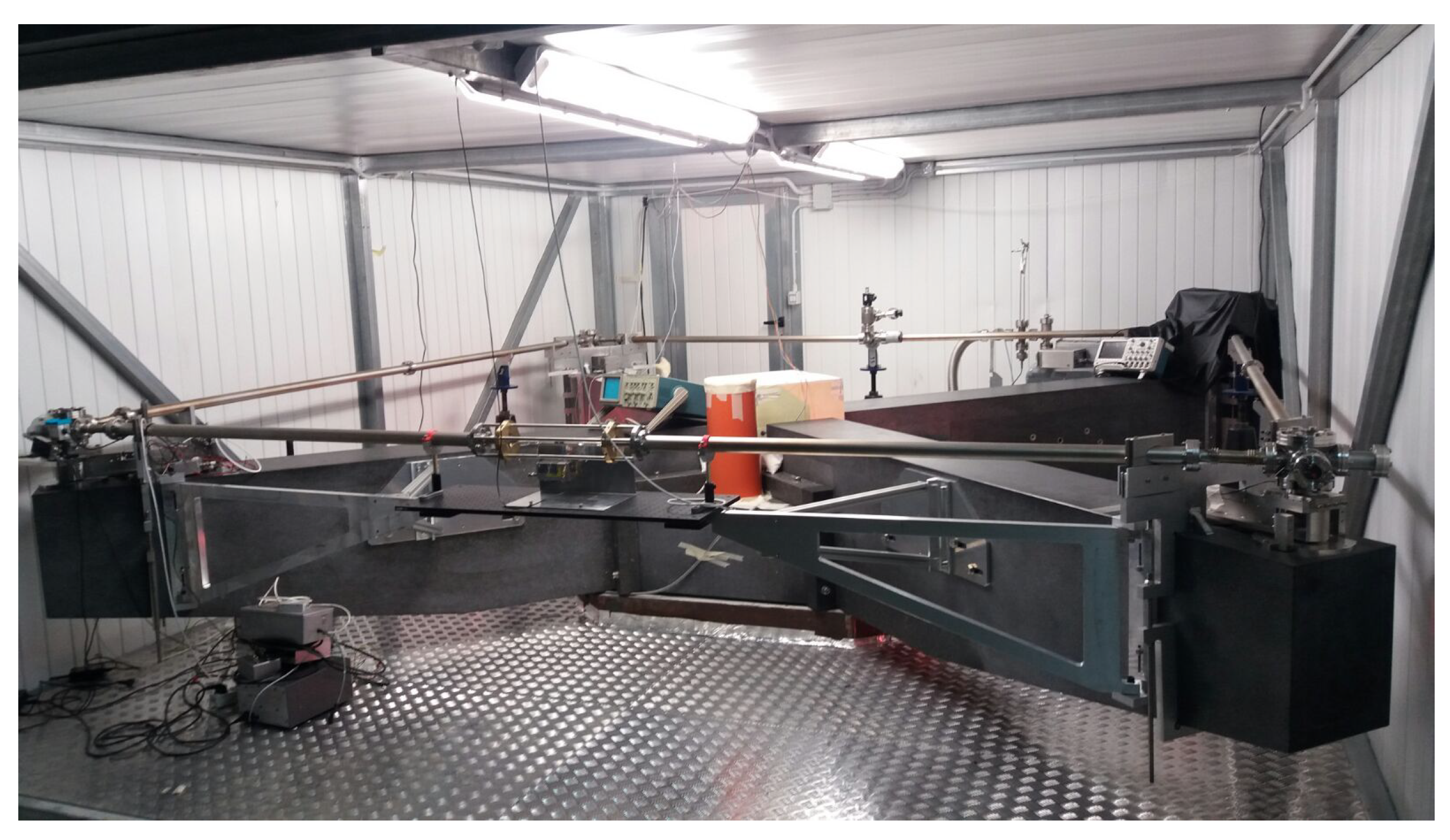
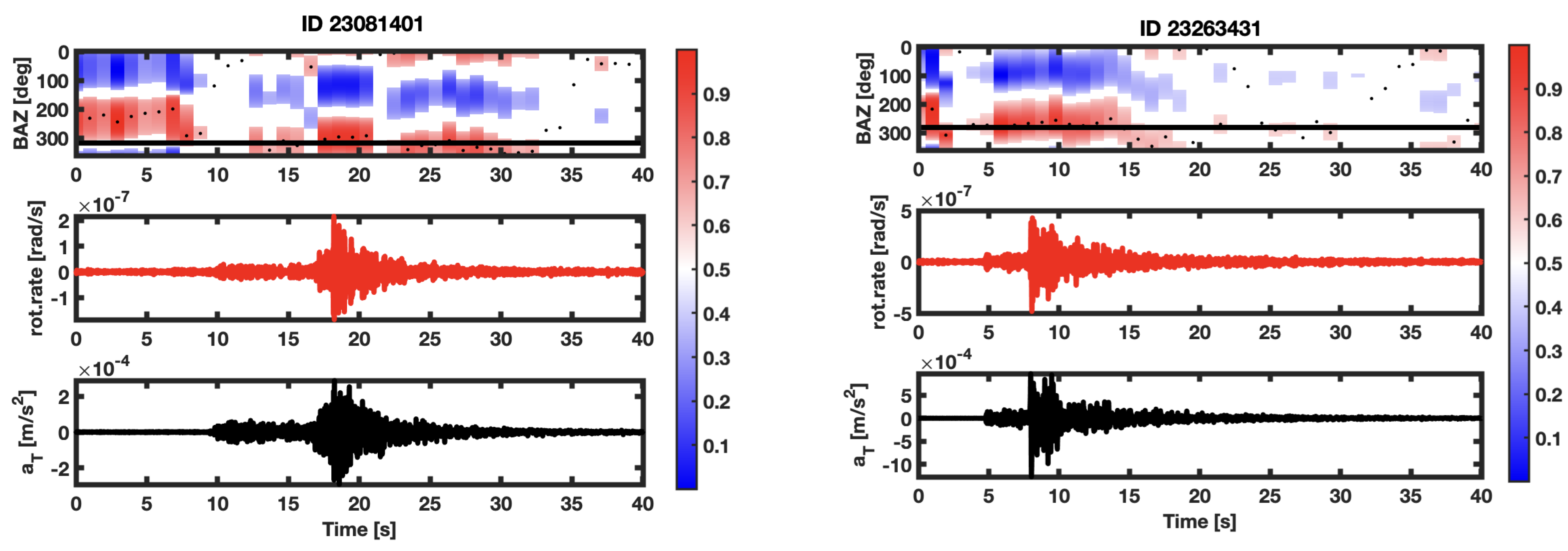


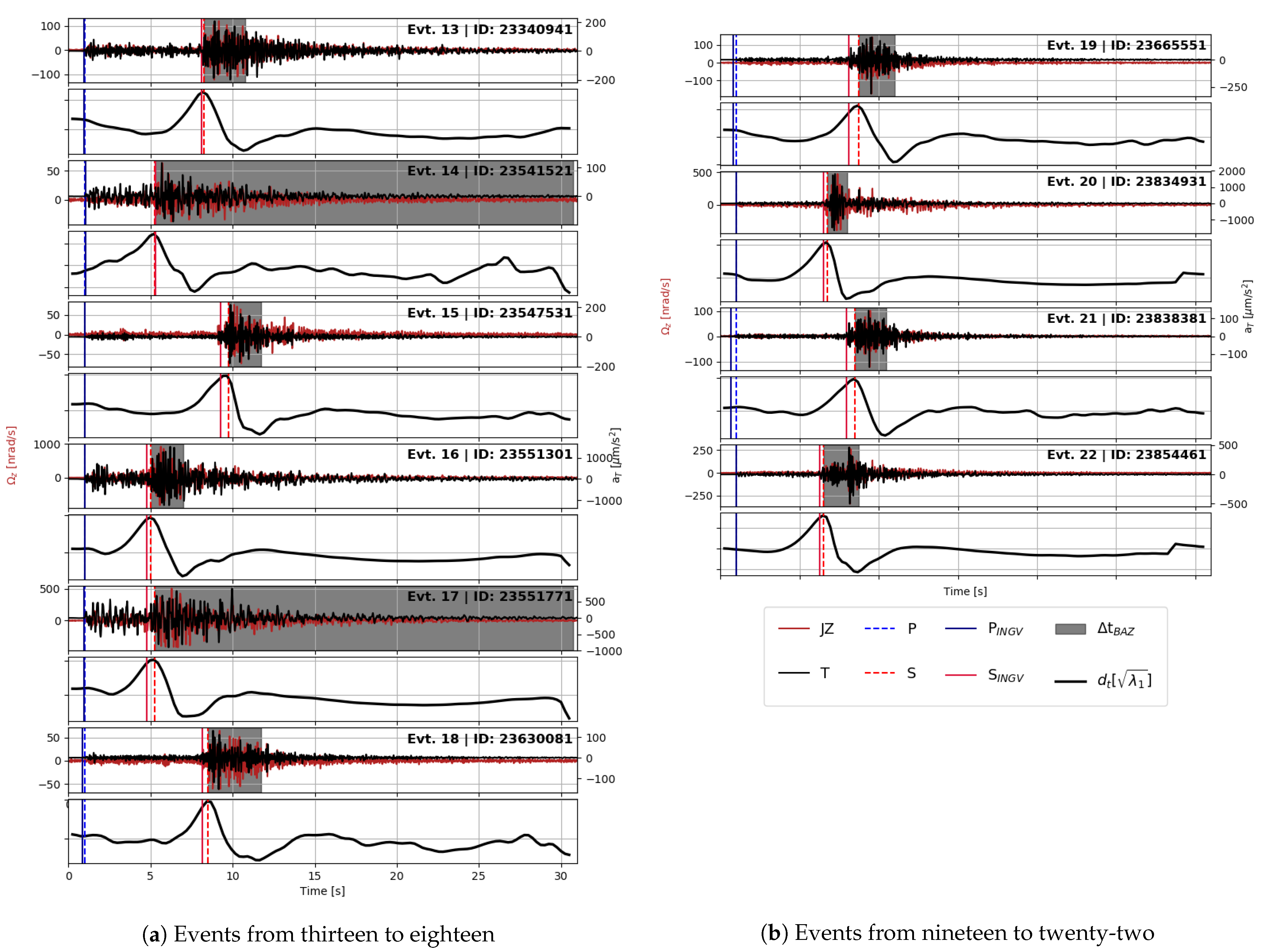
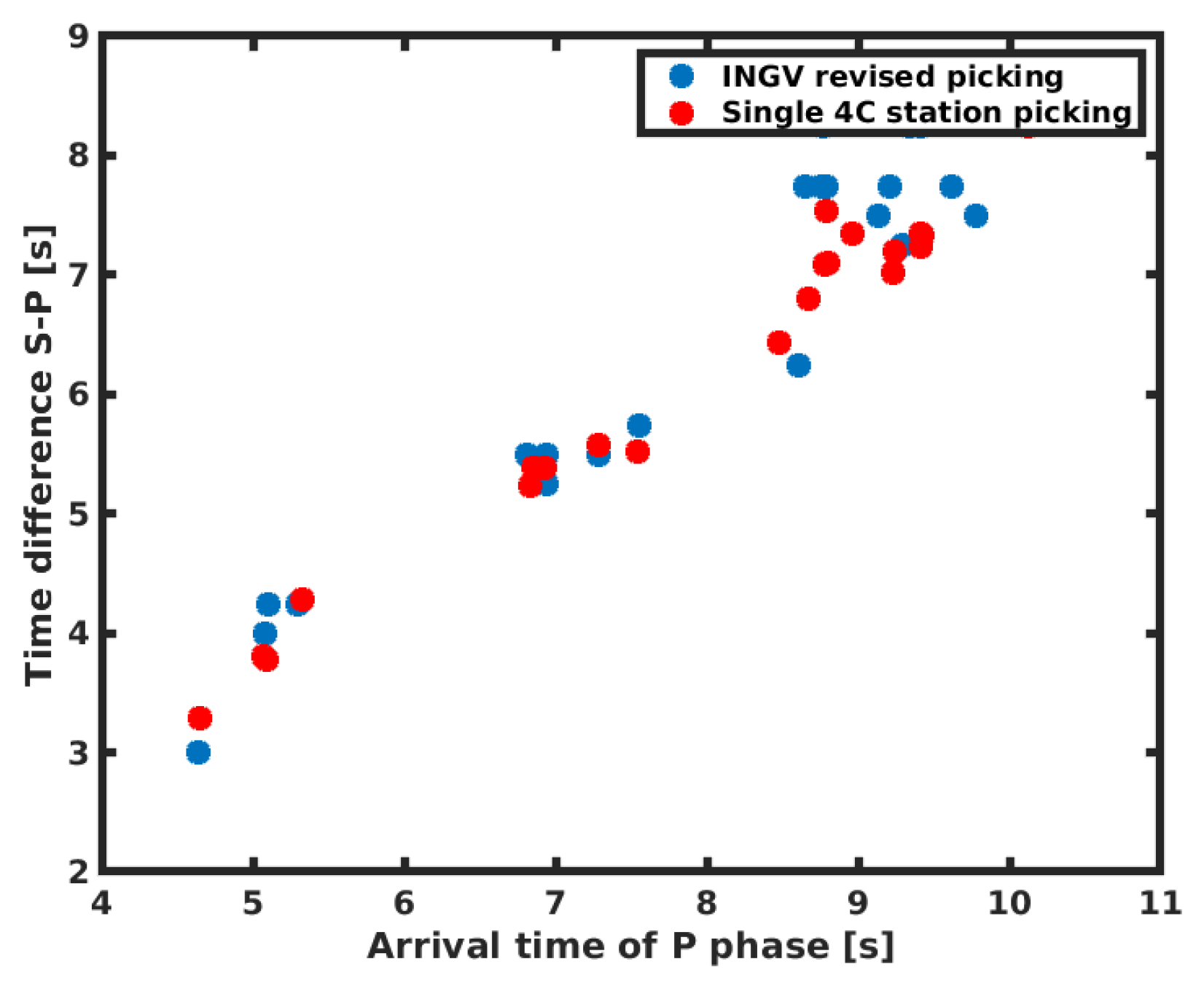
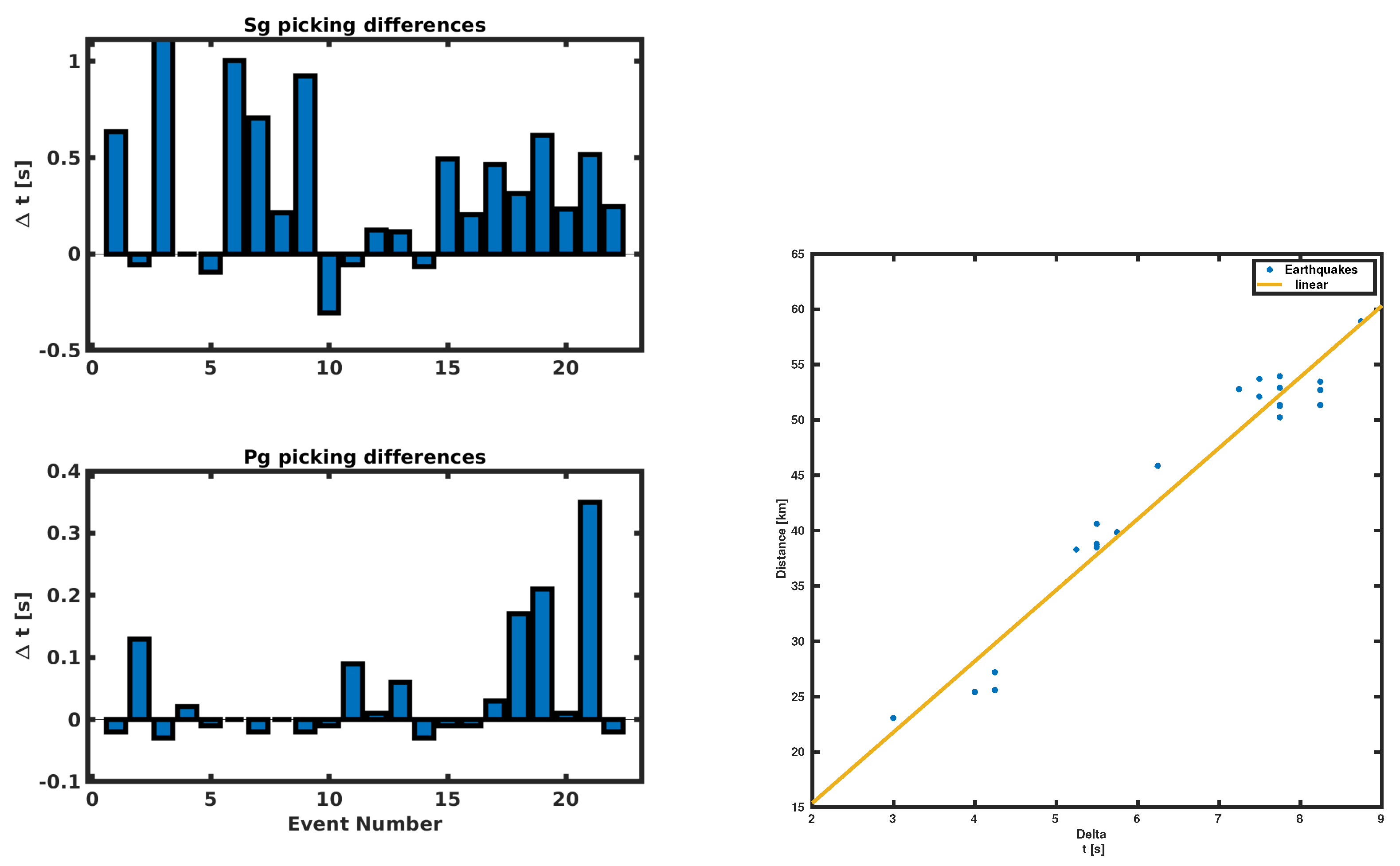
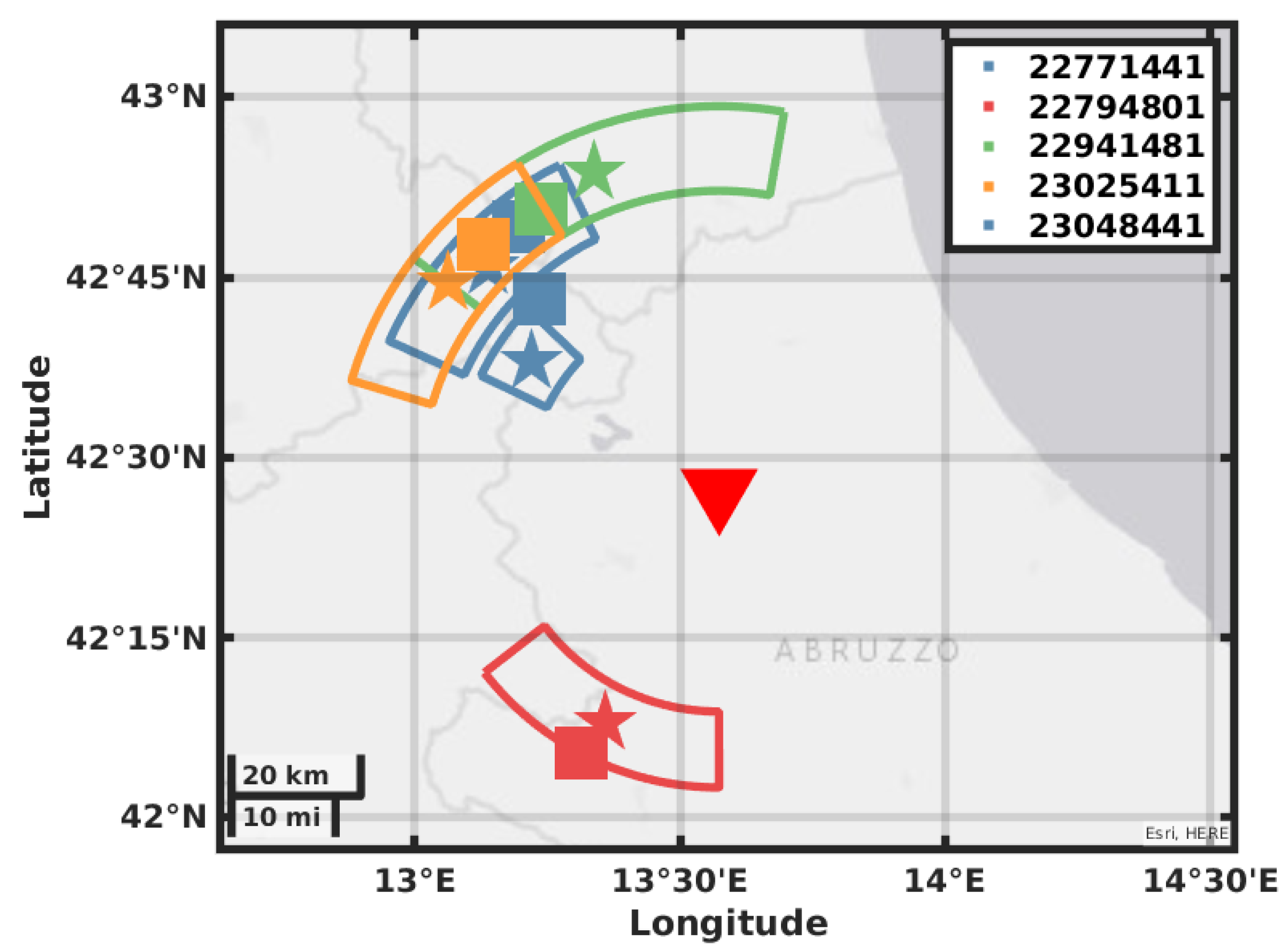
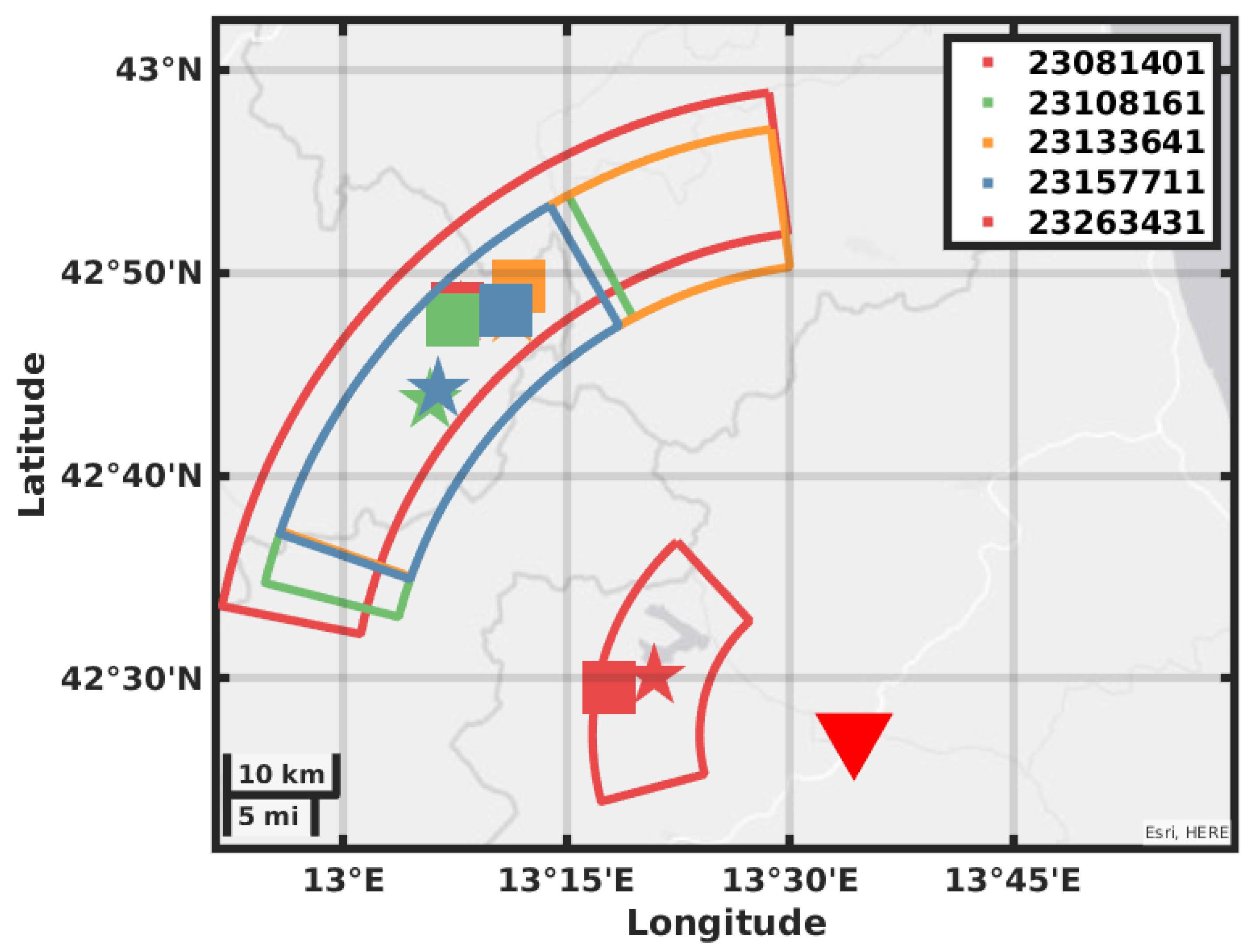
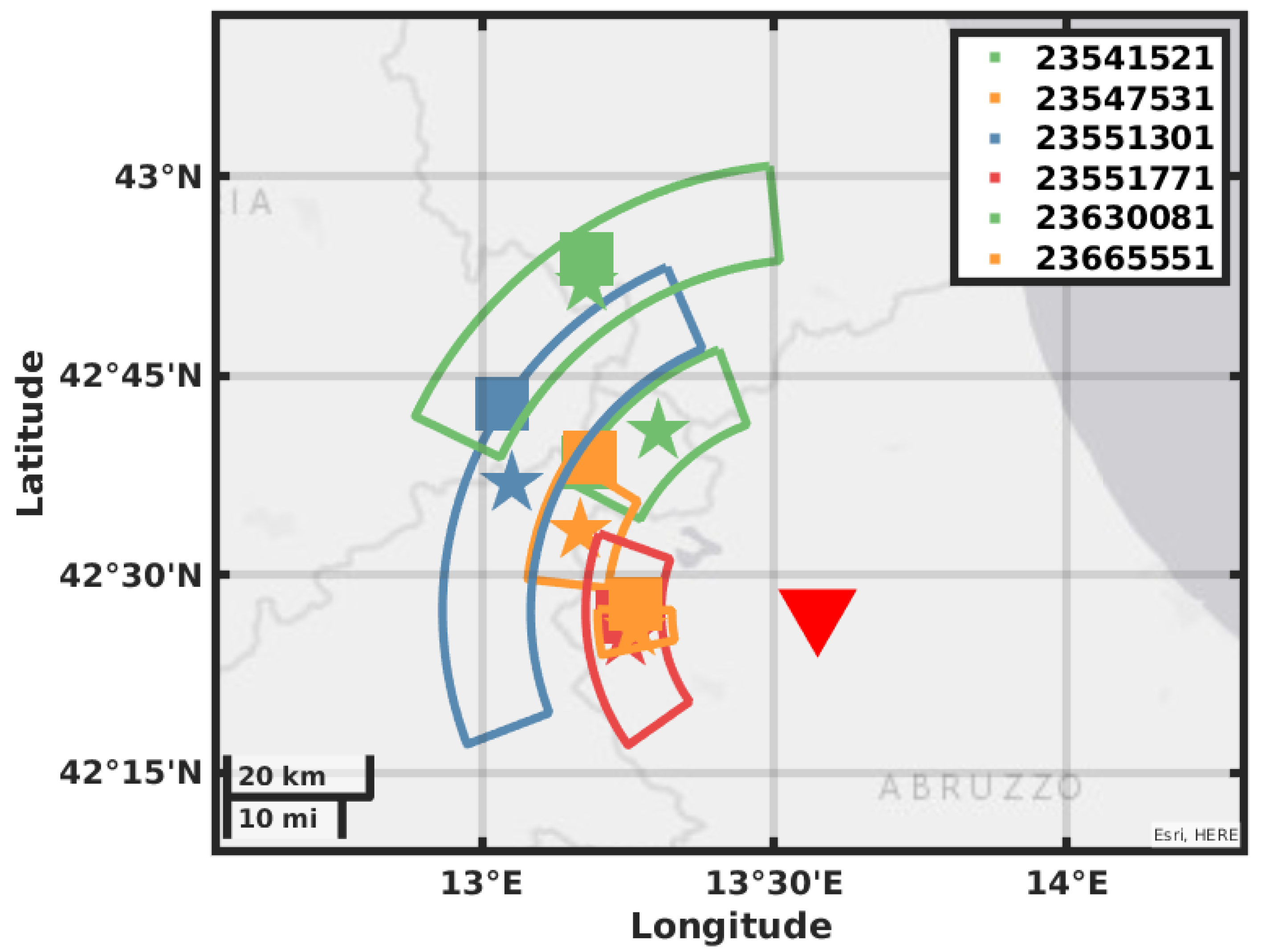
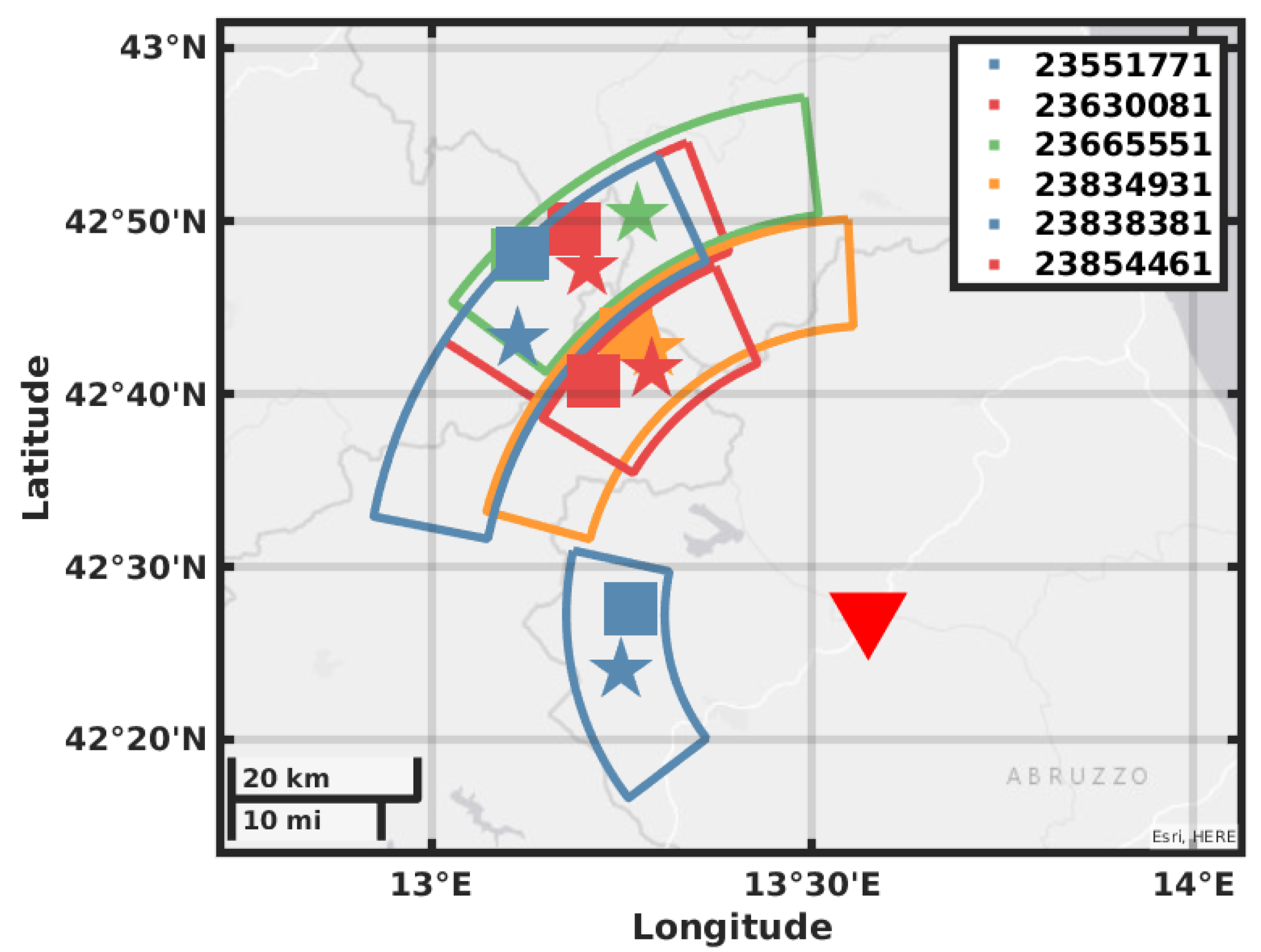
| ev_ID | Time | Lat | Lon | Dist. [km] | Depth [km] | Mag (ML) |
|---|---|---|---|---|---|---|
| 22771441 | 2019-07-30 07:53:43.230 | 42.821 | 13.1952 | 51.2556652901561 | 9.8 | 2.9 |
| 22794801 | 2019-08-03 08:39:50.240 | 42.0882 | 13.3133 | 45.8580189202651 | 9.7 | 2.6 |
| 22941481 | 2019-08-26 07:23:37.800 | 42.8433 | 13.2367 | 51.358086956751 | 10.9 | 2.8 |
| 23025411 | 2019-09-05 04:03:56.220 | 42.7957 | 13.1277 | 52.698075225214 | 9.1 | 2.6 |
| 23048441 | 2019-09-08 16:28:13.460 | 42.7203 | 13.2345 | 40.6142950290862 | 10 | 2.5 |
| 23081401 | 2019-09-14 10:18:13.420 | 42.8047 | 13.1272 | 53.4519454861873 | 9.6 | 2.8 |
| 23108161 | 2019-09-18 19:36:43.750 | 42.7952 | 13.1232 | 52.9133199257223 | 9.4 | 3.2 |
| 23133641 | 2019-09-22 01:28:40.010 | 42.8225 | 13.1958 | 51.3591488287935 | 9.6 | 3 |
| 23157711 | 2019-09-25 10:41:44.590 | 42.8022 | 13.183 | 50.2341404536896 | 10.1 | 2.5 |
| 23263431 | 2019-10-12 12:29:55.330 | 42.4923 | 13.2968 | 23.0538380588901 | 9.9 | 3.1 |
| 23271311 | 2019-10-14 06:28:51.610 | 42.6413 | 13.1813 | 38.2932402297496 | 10.8 | 2.5 |
| 23272401 | 2019-10-14 09:02:38.400 | 42.6467 | 13.1833 | 38.4874482403291 | 9.4 | 2.6 |
| 23340941 | 2019-10-28 07:14:39.080 | 42.7148 | 13.035 | 52.7755051887485 | 9.8 | 3 |
| 23541521 | 2019-12-05 16:08:25.890 | 42.4468 | 13.2413 | 27.2104978980552 | 11.3 | 2.5 |
| 23547531 | 2019-12-07 05:31:02.320 | 42.8967 | 13.1787 | 58.9109750493387 | 9.6 | 2.6 |
| 23551301 | 2019-12-07 21:55:38.130 | 42.4628 | 13.2633 | 25.4155919945919 | 13.7 | 3.8 |
| 23551771 | 2019-12-07 22:16:54.620 | 42.4602 | 13.261 | 25.5941756227566 | 10.6 | 3.4 |
| 23630081 | 2019-12-20 23:19:58.450 | 42.8263 | 13.1873 | 52.1148418310692 | 10.6 | 2.5 |
| 23665551 | 2019-12-25 23:26:37.320 | 42.8007 | 13.1127 | 53.9493563219997 | 9 | 2.6 |
| 23834931 | 2020-01-28 16:37:34.640 | 42.7243 | 13.2548 | 39.8346087439138 | 8.2 | 3.3 |
| 23838381 | 2020-01-29 01:24:59.840 | 42.8028 | 13.1197 | 53.7196183595932 | 9.8 | 2.5 |
| 23854461 | 2020-02-01 15:09:49.410 | 42.6793 | 13.2117 | 38.8191854652558 | 10.1 | 2.8 |
| ev_ID | P DATE | P_INGV | P_picked | S_INGV | S_picked |
|---|---|---|---|---|---|
| 22771441 | 30-Jul-2019 | 07:53:52:010 | 07:53:51:990 | 07:53:59:100 | 07:53:59:735 |
| 22794801 | 03-Aug-2019 | 08:39:58:720 | 08:39:58:850 | 08:40:05:150 | 08:40:05:095 |
| 22941481 | 26-Aug-2019 | 07:23:46:600 | 07:23:46:570 | 07:23:53:700 | 07:23:54:815 |
| 23025411 | 05-Sep-2019 | 04:04:05:540 | 04:04:05:561 | 08:47:04:561 | 04:04:13:806 |
| 23048441 | 08-Sep-2019 | 16:28:20:750 | 16:28:20:740 | 16:28:26:330 | 16:28:26:235 |
| 23081401 | 14-Sep-2019 | 10:18:22:830 | 10:18:22:830 | 10:18:30:070 | 10:18:31:075 |
| 23108161 | 18-Sep-2019 | 19:36:52:980 | 19:36:52:960 | 19:37:00:000 | 19:37:00:705 |
| 23133641 | 22-Sep-2019 | 01:28:48:800 | 01:28:48:800 | 01:28:56:330 | 01:28:56:545 |
| 23157711 | 25-Sep-2019 | 10:41:53:260 | 10:41:53:240 | 10:42:00:060 | 10:42:00:985 |
| 23263431 | 12-Oct-2019 | 12:29:59:980 | 12:29:59:970 | 12:30:03:270 | 12:30:02:965 |
| 23271311 | 14-Oct-2019 | 06:28:58:460 | 06:28:58:550 | 06:29:03:850 | 06:29:03:795 |
| 23272401 | 14-Oct-2019 | 09:02:45:330 | 09:02:45:340 | 09:02:50:710 | 09:02:50:835 |
| 23340941 | 28-Oct-2019 | 07:14:48:320 | 07:14:48:380 | 07:14:55:510 | 07:14:55:625 |
| 23541521 | 05-Dec-2019 | 16:08:31:220 | 16:08:31:190 | 16:08:35:500 | 16:08:35:435 |
| 23547531 | 07-Dec-2019 | 05:31:12:440 | 05:31:12:430 | 05:31:20:680 | 05:31:21:175 |
| 23551301 | 07-Dec-2019 | 21:55:43:220 | 21:55:43:210 | 21:55:47:000 | 21:55:47:205 |
| 23551771 | 07-Dec-2019 | 22:16:59:690 | 22:16:59:720 | 22:17:03:500 | 22:17:03:965 |
| 23630081 | 20-Dec-2019 | 23:20:07:410 | 23:20:07:580 | 23:20:14:760 | 23:20:15:075 |
| 23665551 | 25-Dec-2019 | 23:26:46:730 | 23:26:46:940 | 23:26:54:070 | 23:26:54:685 |
| 23834931 | 28-Jan-2020 | 16:37:42:180 | 16:37:42:190 | 16:37:47:700 | 16:37:47:935 |
| 23838381 | 29-Jan-2020 | 01:25:09:270 | 01:25:09:620 | 01:25:16:600 | 01:25:17:115 |
| 23854461 | 01-Feb-2020 | 15:09:56:240 | 15:09:56:220 | 15:10:01:470 | 15:10:01:715 |
| Event ID | D [km] | HypD [km] | EST. D [km] | D | BAZ [deg] | EST. BAZ [deg] | BAZ |
|---|---|---|---|---|---|---|---|
| 22771441 | 51.2556652901561 | 52.1841280883039 | 49.5679950714111 | 6 | 323.065506757991 | 328 | 28 |
| 22794801 | 45.8580189202651 | 46.8726775349072 | 39.9680471420288 | 5 | 207.841005121603 | 185 | 18 |
| 22941481 | 51.358086956751 | 52.502029445129 | 52.7679777145386 | 6 | 327.750507363209 | 330 | 3 |
| 23025411 | 52.698075225214 | 53.4780060627013 | 52.7679777145386 | 6 | 316.432971160146 | 312 | 13 |
| 23048441 | 40.6142950290862 | 41.8272753201742 | 35.1680088043213 | 5 | 317.115124375038 | 352 | 37 |
| 23081401 | 53.4519454861873 | 54.3071862303538 | 52.7679777145386 | 6 | 317.144876972473 | 303 | 40 |
| 23108161 | 52.9133199257223 | 53.7417847262429 | 49.5679950714111 | 6 | 316.104623798978 | 323 | 9 |
| 23133641 | 51.3591488287935 | 52.2486570967921 | 49.5679950714111 | 6 | 323.221471377853 | 330 | 7 |
| 23157711 | 50.2341404536896 | 51.23942688127 | 49.5679950714111 | 6 | 320.719262138433 | 319 | 24 |
| 23263431 | 23.0538380588901 | 25.089628320195 | 19.1680312156677 | 4 | 280.972959907815 | 295 | 24 |
| 23271311 | 38.2932402297496 | 39.7870864388599 | 33.5679531097412 | 5 | 303.245455188636 | 309 | 2 |
| 23272401 | 38.4874482403291 | 39.6187288040898 | 35.1680088043213 | 5 | 304.127897489016 | 311 | 26 |
| 23340941 | 52.7755051887485 | 53.6776857542091 | 46.3680124282837 | 6 | 303.634132116785 | 308 | 20 |
| 23541521 | 27.2104978980552 | 29.4635570809104 | 27.1679878234863 | 5 | 268.620966580245 | 275 | 6 |
| 23547531 | 58.9109750493387 | 59.688047222738 | 55.9680247306824 | 6 | 326.975839950607 | 329 | 2 |
| 23551301 | 25.4155919945919 | 28.8728647078111 | 25.5679965019226 | 5 | 272.519915351149 | 281 | 1 |
| 23551771 | 25.5941756227566 | 27.7023794250333 | 27.1679878234863 | 5 | 271.856197317918 | 261 | 1 |
| 23630081 | 52.1148418310692 | 53.181921167605 | 47.9680037498474 | 6 | 322.892905049481 | 293 | 24 |
| 23665551 | 53.9493563219997 | 54.6949087901067 | 49.5679950714111 | 6 | 315.905232456936 | 319 | 2 |
| 23834931 | 39.8346087439138 | 40.6698420673193 | 36.768000125885 | 5 | 319.294223601461 | 332 | 7 |
| 23838381 | 53.7196183595932 | 54.606202914141 | 47.9680037498474 | 6 | 316.51468132474 | 315 | 7 |
| 23854461 | 38.8191854652558 | 40.1115838653366 | 35.1680088043213 | 5 | 310.493568388689 | 313 | 13 |
Publisher’s Note: MDPI stays neutral with regard to jurisdictional claims in published maps and institutional affiliations. |
© 2021 by the authors. Licensee MDPI, Basel, Switzerland. This article is an open access article distributed under the terms and conditions of the Creative Commons Attribution (CC BY) license (https://creativecommons.org/licenses/by/4.0/).
Share and Cite
Simonelli, A.; Desiderio, M.; Govoni, A.; De Luca, G.; Di Virgilio, A. Monitoring Local Earthquakes in Central Italy Using 4C Single Station Data. Sensors 2021, 21, 4297. https://doi.org/10.3390/s21134297
Simonelli A, Desiderio M, Govoni A, De Luca G, Di Virgilio A. Monitoring Local Earthquakes in Central Italy Using 4C Single Station Data. Sensors. 2021; 21(13):4297. https://doi.org/10.3390/s21134297
Chicago/Turabian StyleSimonelli, Andreino, Matteo Desiderio, Aladino Govoni, Gaetano De Luca, and Angela Di Virgilio. 2021. "Monitoring Local Earthquakes in Central Italy Using 4C Single Station Data" Sensors 21, no. 13: 4297. https://doi.org/10.3390/s21134297
APA StyleSimonelli, A., Desiderio, M., Govoni, A., De Luca, G., & Di Virgilio, A. (2021). Monitoring Local Earthquakes in Central Italy Using 4C Single Station Data. Sensors, 21(13), 4297. https://doi.org/10.3390/s21134297






